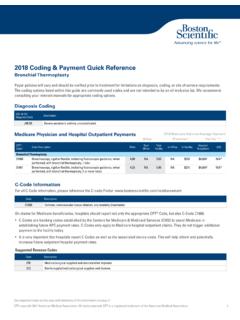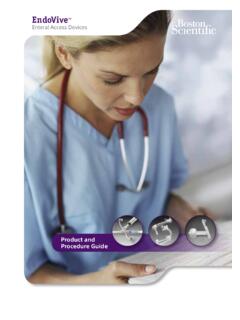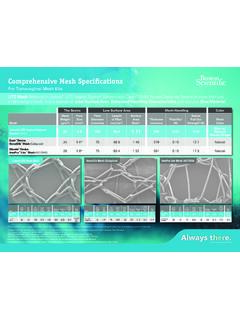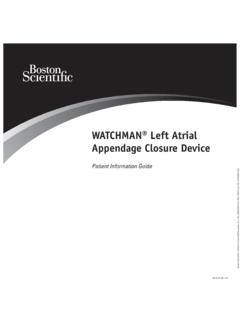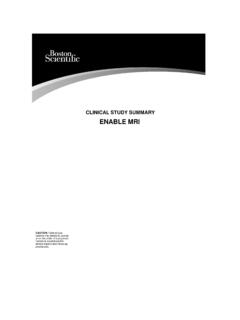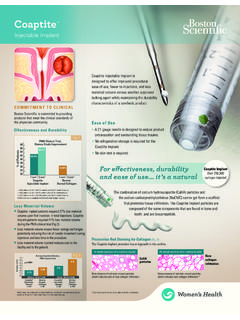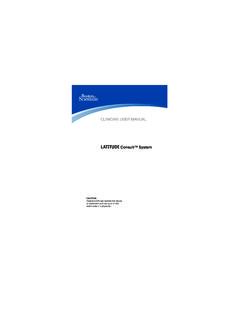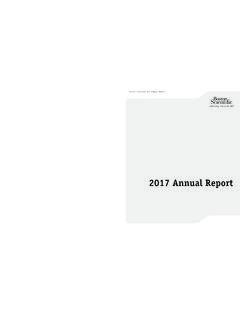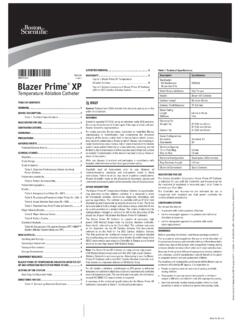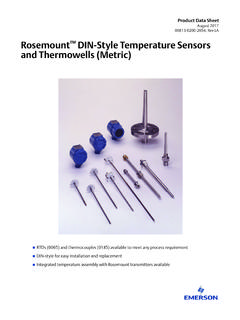Transcription of ImageReadyTM MR-Conditional Model List - Boston Scientific
1 MR-Conditional * Model List* Therapy Device Name Device Model Numbers MRI System Configuration ICM LUX-Dx M301 or 3T Pacemakers ACCOLADE MRI ESSENTIO MRI L310, L311, L331 or 3T L110, L111, L131 VITALIO MRI1 K275, K277 MRI-compatible onlyS-ICDEMBLEM A209 EMBLEM MRI A219 CRT-P VISIONIST X4 U228 or 3T VALITUDE X4 U128 ICDs RESONATE HF D532, D533 or 3T RESONATE D432, D433 VIGILANT D232, D233 PERCIVA DF4 D412, D413 PERCIVA DF1 D400, D401 D120, D121 AUTOGEN D160, D161, D162, D163 DYNAGEN D020, D021, D022, D023, D150, D151, D152, D153 INOGEN D010, D011, D012, D013, D140, D141, D142, D143 CRT-Ds RESONATE HF G547 or 3T RESONATE G447 VIGILANT G247, G248 MOMENTUM G124, G125, G138 G160, G161, G166, G168 DYNAGEN G150, G151, G156, G158 INOGEN G140, G141, G146, G148 The following leads and accessories are labeled as MR-Conditional * IINNGGEEVVIITTYYTTMM MMRRII:: 7735, 7736, 7740, 7741, 7742 IINNGGEEVVIITTYYTTMM MMRRII:: 7731, 7732 (Not valid with ICDs or CRT-Ds) IINNGGEEVVIITTYYTTMM+:: 7840,7841, 7842 FFIINNEELLIINNEETTMM IIII:: 4469, 4470, 4471, 4472, 4473, 4474, 4479, 4480 (Not valid with VITALIO MRI.)
2 FFIINNEELLIINNEETTMM IIII:: 4456, 4457, 4458, 4459 (Not valid with VITALIO MRI. Not valid with ICDs or CRT-Ds) EENNDDOOTTAAKK RREELLIIAANNCCEETTMM 44--SSIITTEETTMM ((DDFF44)):: 0262, 0263, 0265, 0266, 0272, 0273, 0275, 0276, 0282, 0283, 0285, 0286, 0292, 0293, 0295, 0296 EENNDDOOTTAAKK RREELLIIAANNCCEETTMM ((DDFF11)):: 0127, 0128, 0129, 0137, 0138, 0139, 0143, 0147, 0148, 0149, 0153, 0157, 0158, 0159, 0170, 0171, 0172, 0173,0174, 0175, 0176, 0177, 0180, 0181, 0182, 0183, 0184, 0185, 0186, 0187 RREELLIIAANNCCEETTMM 44--FFRROONNTTTTMM:: 0636, 0650, 0651, 0652, 0653, 0654, 0655, 0657, 0658, 0662, 0663, 0665, 0672, 0673, 0675, 0676, 0682, 0683,0685,0686, 0692, 0693, 0695, 0696 AACCUUIITTYYTTMM XX44.
3 4671, 4672, 4674, 4675, 4677, 4678 EEAASSYYTTRRAAKKTTMM 22:: 4542, 4543, 4544 AACCUUIITTYYTTMM SSppiirraall:: 4591, 4592, 4593 SS--IICCDD EELLEECCTTRROODDEESS:: 3010, 3400, 3401, 3501 SSuuttuurree SSlleeeevveess:: 4603, 6100, 6220, 6221, 6402, 6403, 6773 PPoorrtt PPlluuggss:: 7145, 7148* When conditions of use are VITALIO MRI is only MR-Conditional with INGEVITY MRI/INGEVITY+ d ocument contains Boston Scientific CRM devices that are approved by the FDA as MR-C onditional as of January 2020. Visit for additional information cardiology/radiology checklists, patient resources, and the MRI technical MR-Conditional * Model List*TherapyDevice NameDevice Model NumbersMRI System or 3 TPacemakersACCOLADETM MRIESSENTIOTM MRIL310, L311, or 3TL110, L111, L131 VITALIOTM MRI1K275, MRIA219 CRT-PVISIONISTTM or 3 TVALITUDETM X4U128 ICDsRESONATETM HFD532, or 3 TRESONATETMD432, D433 VIGILANTTMD232, D233 PERCIVATM DF4D412, D413 PERCIVATM DF1D400, , D121 AUTOGENTMD160, D161, D162, D163 DYNAGENTMD020, D021, D022, D023, D150, D151, D152, D153 INOGENTMD010, D011, D012, D013, D140, D141, D142.
4 D143 CRT-DsRESONATETM or MOMENTUMTMG124, G125, , G161, G166, G168 DYNAGENTMG150, G151, G156, G158 INOGENTMG140, G141, G146, G148 Pacing Systems ACCOLADE , ACCOLADE MRI, PROPONENT , PROPONENT MRI, ESSENTIO , ESSENTIO MRI, ALTRUA 2, FORMIO , FORMIO MRI, VITALIO , VITALIO MRI, INGENIO , INGENIO MRI, ADVANTIO PACEMAKERINDICATIONS AND USAGE Boston Scientific pacemakers are indicated for treatment of the following conditions: Symptomatic paroxysmal or permanent second- or third-degree AV block Symptomatic bilateral bundle branch block Symptomatic paroxysmal or transient sinus node dysfunction with or without associated AV conduction disorders ( , sinus bradycardia, sinus arrest, sinoatrial [SA] block) Bradycardia-tachycardia syndrome, to prevent symptomatic bradycardia or some forms of symptomatic tachyarrhythmias Neurovascular (vaso-vagal)
5 Syndromes or hypersensitive carotid sinus syndromes Adaptive-rate pacing is indicated for patients exhibiting chronotropic incompetence and who may benefit from increased pacing rates concurrent with increases in minute ventilation and/or level of physical activity. Dual-chamber and atrial tracking modes are also indicated for patients who may benefit from maintenance of AV synchrony. Dual chamber modes are specifically indicated for treatment of the following: Conduction disorders that require restoration of AV synchrony, including varying degrees of AV block VVI intolerance ( , pacemaker syndrome) in the presence of persistent sinus rhythm Low cardiac output or congestive heart failure secondary to bradycardiaCONTRAINDICATIONS These Boston Scientific pacemakers are contraindicated in patients who have a separate implanted cardioverter defibrillator (ICD) with transvenous leads.
6 Use of certain pacing modes and/or features available in these Boston Scientific pacemakers is contraindicated for the following patients under the circumstances listed: Unipolar pacing or use of the MV sensor with a Subcutaneous Implantable Cardioverter Defibrillator (S-ICD) because it may cause inappropriate therapy or inhibition of appropriate S-ICD therapy. Minute Ventilation in patients with both unipolar atrial and ventricular leads Single-chamber atrial pacing in patients with impaired AV nodal conduction Atrial tracking modes for patients with chronic refractory atrial tachyarrhythmias (atrial fibrillation or flutter), which might trigger ventricular pacing Dual-chamber and single-chamber atrial pacing in patients with chronic refractory atrial tachyarrhythmias Asynchronous pacing in the presence (or likelihood) of competition between paced and intrinsic rhythmsWARNINGS Read this manual thoroughly before implantation to avoid damage to the pulse generator and/or lead.
7 Such damage can result in patient injury or death. For single patient use only. Do not reuse, reprocess, or resterilize. Always have external defibrillation equipment available during implant and electrophysiologic testing. Using multiple pulse generators could cause pulse generator interaction, resulting in patient injury or a lack of therapy delivery. In response to applicable nonrecoverable or repeat fault conditions, the pulse generator will switch irreversibly to Safety Core operation. Do not kink, twist, or braid the lead with other leads. Do not use atrial tracking modes in patients with chronic refractory atrial tachyarrhyth-mias. Lead Safety Switch should be programmed Off for patients with an ICD.
8 Unipolar pacing due to Lead Safety Switch is contraindicated for patients with an ICD. Automatic Lead Recognition should be programmed to Off before implant for patients with an ICD. Unipolar pacing due to RAAT is contraindicated and should be programmed off for patients with an ICD. If programmed to a fixed atrial Sensitivity value of mV, or a fixed sensitivity value of mV or less in a unipolar lead configuration in any chamber, the pulse generator may be more susceptible to electromagnetic interference. Advise patients to seek medical guidance before entering environments that could adversely affect the operation of the active implantable medical device.
9 ACCOLADE MRI, PROPONENT MRI, ESSENTIO MRI, FORMIO MRI, VITALIO MRI and INGENIO MRI devices are considered MRI Conditional. For these devices, unless all of the MRI Conditions of Use are met, MRI scanning of the patient does not meet MR Conditional requirements for the implanted system. Significant harm to or death of the patient and/or damage to the implanted system may result. All other devices covered by this statement are not MR conditional. For potential adverse events applicable when the Conditions of Use are met or not met, refer to the MRI Technical Guide. Do not subject a patient with an implanted pulse generator and/or lead to diathermy. PRECAUTIONS For specific information on precautions, refer to the following sections of the product labeling: clinical considerations, sterilization and storage, implantation, device programming, environmental and medical therapy hazards, hospital and medical environments, home and occupational environments, follow up testing, explant and disposal, supplemental precautionary ADVERSE EVENTS Based on the literature and on pulse generator and/or lead implant experience, the following alphabetical list includes the possible adverse events associated with implantation of the included devices: Air embolism; Allergic reaction; Bleeding; Bradycardia.
10 Cardiac tamponade; Chronic nerve damage; Component failure; Conductor coil fracture; Death; Elevated thresholds; Erosion; Excessive fibrotic tissue growth; Extracardiac stimulation (muscle/nerve stimulation); Fluid accumulation; Foreign body rejection phenomena; Formation of hematomas or seromas; Heart block; Heart failure following chronic RV apical pacing; Inability to pace; Inappropriate pacing; Incisional pain; Incomplete lead connection with pulse generator; Infection including endocarditis; Lead dislodgement; Lead fracture; Lead insulation breakage or abrasion; Lead perforation; Lead tip deformation and/or breakage; Local tissue reaction; Loss of capture; Myocardial infarction (MI); Myocardial necrosis; Myocardial trauma ( , tissue damage, valve damage); Myopotential sensing; Oversensing/undersensing; Pacemaker-mediated tachycardia (PMT) (applies to dual-chamber devices only); Pericardial rub, effusion; Pneumothorax; Pulse generator migration; Shunting current during defibrillation with internal or external paddles; Syncope; Tachyarrhythmias, which include acceleration of arrhythmias and early, recurrent atrial fibrillation; Thrombosis/thromboemboli; Valve damage; Vasova-gal response; Venous occlusion; Venous trauma ( , perforation; dissection, erosion); Worsening heart failure.
